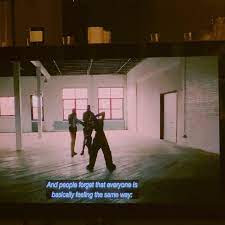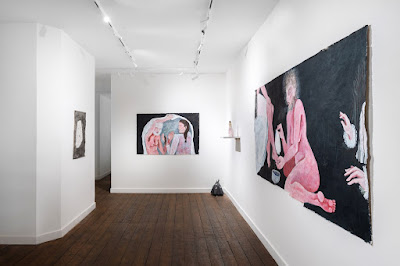Social media can coax you into genuinely believing that some people are hoarding all the happiness.
Being sad online is an alienating experience. As with most social media posting, it is not without its consequences, and almost every day (depending on how active you are on the various platforms) you have to make a conscious decision about how visible you are, how authentic you want to be with your audience. Being online at all is an exercise in branding, and thinking back into the lockdowns, which I cannot help but do frequently, it became for many the sole outlet for social interactions, while we were in a state-mandated ban from being together. Screens were people, people were screens.
So what do I mean when I talk about 'being sad online'? We have all worked out by now that any online presence is performative, even on a subconscious level; I can tell you something face-to-face in seconds, but online I can reword, erase and edit myself until my self-expression is highly contrived and polished: "on brand". Lest we forget, our output can be screenshot and circulated at any time. I think, here, of 'being sad' as something far more than merely the lower end of the emotional spectrum. I am not talking about something being universally sad, or tragic; the dissemination of war and other traumatic imagery requires our attention and action in a wholly separate manner. I am directly addressing the mental health epidemic we are facing as a society and as individuals.
On Instagram, for example, on my timeline there are some women who post about mental health in the first person, and during dark episodes, it can be helpful to see other people going through similar things. Somehow, releasing it into the social media ether, or indeed seeing yourself reflected in another person's post, lessens the emotional weight of the content, and an illusory warmth of community, of solidarity, is regained. It is worth considering, though, that the accounts that immediately spring to mind have followers in their thousands. One can safely assume that these thousands of people, predominantly strangers, do not care for, or at least have much of a stake in, these individuals in much depth. Instagram in particular is image-heavy, as per its USP, so it often feels strange and voyeuristic in a different way when people overshare on their Instagram stories, for instance. This irk also works the other way round; some of the excessive smiling and forced laughter on Instagram can make for a similarly uncomfortable viewing experience. Who, or what is this all for? Essentially, although businesses and the like can strike gold on Instagram, given its high capacity for marketing and sales, it is a virtual site for neutrality and generic aesthetics. With the introduction of Instagram Stories, browsing the app has been 'Tinder-ised', we might argue. It is a swiping game whereby we need a fleeting distraction, be it from boredom or our own difficulties; we don't want to be moved. The art world also does well on Instagram, but even then, installation views of exhibitions and artworks are still highly formulaic, even the ones that perform well for being particularly 'Instagrammable' or 'Insta-friendly'.

Still from a video posted by Bella Hadid on 9 November 2021. Copyright Bella Hadid / Instagram. @bellahadid
Perhaps the key to embracing your sadness online is to consider two things: what is the most therapeutic for you (i.e. what will actually help you) and what is at stake by an admission of sadness to your audience. If we are all branding projects, is sharing an earnest post about a mental health struggle a "crisis communication"? In an age of relentless loneliness, sometimes it might feel like the only option available. Supermodel Bella Hadid recently did an interview with WSJ Magazine and separately posted on her Instagram about experiencing "excruciating physical and mental pain"(1), linked to her Lyme's Disease diagnosis as well as mental health struggles. There is much at stake for a high-profile woman in the media to speak openly about mental health, while illustrating it with selfies of her crying at different times; one only needs to look at Britney Spears. Whilst we could identify Hadid's privilege as a wealthy, white cisgendered woman, as she speaks about a chronic health condition adjacent to depression, this is not the angle I am going to take on this occasion. Given the punishing nature of the modelling occupation, I imagine this was incredibly refreshing not only for her young fans, who will surely be used to positive pseudo-psychology and the generic status quo from their favourite celebrities, but also for her peers.
On the mental health fallout from the pandemic, political philosopher Donatella Di Cesare writes in her wonderful book Immunodemocracy: Capitalist Asphyxia:
"Not everyone has the means to cope with this anxious existence between parentheses - or the capacity to work through their distress. The vain, self satisfied vogue for diaries is echoed by the heaps of consultants and influencers, the latest pseudo-thinkers who regale us with cut-price solutions and advice which no one asked for."(2) [bold added by me]
Whilst Hadid is influential in the traditional sense, I would argue that she is not the kind of influencer that Di Cesare refers to here, and it is very interesting that the model has presented a problem to her followers, as opposed to a solution. Unless she starts doing sponsored advertisements on Instagram for online therapy or the like, she has done well to resist the marketisation on the platform, on this occasion. As I have already discussed, straying from the mediocre, the placid and the generic on social media is not the custom etiquette: you go out, you add a video of your friends dancing to your Stories; you go for brunch and set up a Boomerang of the four of you clinking champagne flutes; you post a photo of yourself inexplicably laughing onto your grid. Where does sadness, or even worse, sickness, fit into all this? You want to get likes, but you don't really want to stand out. You don't want to be accused of being an attention-seeker. If, as Legacy Russell says, the lines between 'real' and online life are blurring beyond recognition, then why is the online domain making sure that stigmatisation around mental health and disabilities remains stagnant, dragging its heels? Presenting ill health, whether physical or mental, online produces a monolithic reception on social media: sheer awkwardness. We consume the information at an arm's length, and when we have to be sincere and subdued, it is difficult when we habitually find ourselves reaching for an emoji.
Perhaps it is the embedded systemic patriarchy that makes sincere expressions of sadness appear cringeworthy, attention-seeking or surplus to requirements. Our relationships with people have been entirely transformed by the combination of life online and the pandemic, so we must legitimise and make space for sadness amongst the banal imagery of weekend brunches, gigs and baby showers (where laughter for the camera is a compulsory accessory). Whether someone has 10 followers or a hundred million, it is surely their prerogative to express their sadness in the same way that they might celebrate their happiness. Can sadness fight the aesthetic paradigms, the algorithm and the commercialisation of social media to present something that is ugly and chronic, yet felt universally? In the depths of my own sadness, making any assumption that sadness is only felt by some and not others would only cause me to sink further. By people sharing their real emotions and challenges, in a way that is comfortable to them, there is surely scope to build hopeful spaces and communities of support rather than vitriol and spite.
---
(1) https://www.vanityfair.com/style/2022/01/bella-hadid-mental-health-depression-anxiety-lyme-disease-wall-street-journal
(2) Di Cesare, Donatella. Immunodemocracy: Capitalist Asphyxia. Cambridge, Mass. and London: MIT Press, 2020, p85
---
(Re)sources:
Campaign Against Living Miserably. Accessed April 10, 2022. https://www.thecalmzone.net
Hedva, Johanna. "Sick Woman Theory." January 19, 2016. https://johannahedva.com/SickWomanTheory_Hedva_2020.pdf
Lovink, Geert. Sad By Design: On Platform Nihilism. London: Pluto Press, 2019
Russell, Legacy. Glitch Feminism: A Manifesto. London and New York: Verso Books, 2020
Samaritans. Accessed April 10, 2022. https://www.samaritans.org



